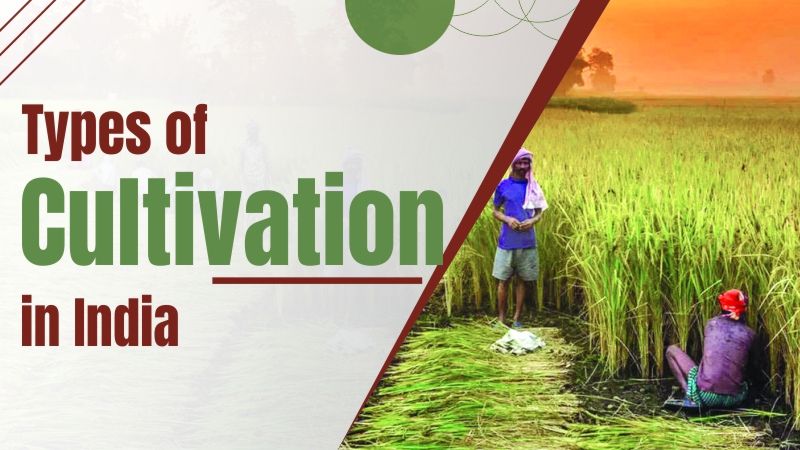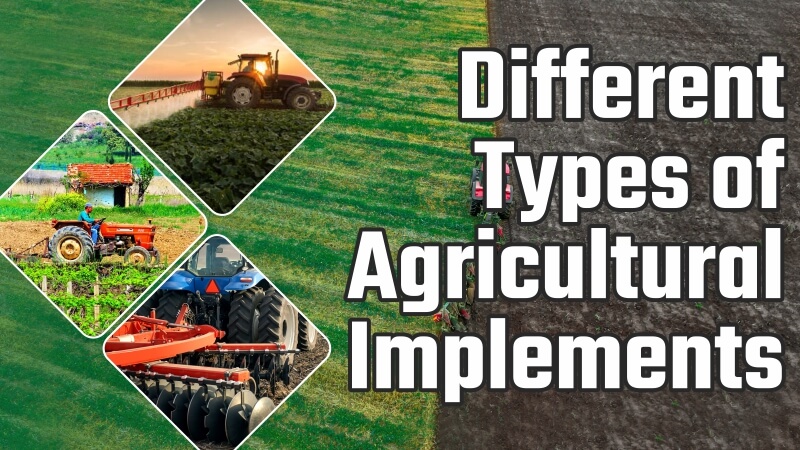Types of Farming in India in 2024
India, with its diverse agro-climatic conditions, practices various types of farming to cater to its large population and growing agricultural demands. Here are some prevalent farming types in India:
1. Subsistence Farming: Most commonly practiced in rural areas, where farmers grow crops primarily for consumption rather than for sale. It relies heavily on traditional methods and manual labor.
2. Commercial Farming: Focuses on growing crops for sale in the market. Crops such as cotton, sugarcane, and tobacco are cultivated on a large scale using modern techniques and machinery.
3. Plantation Farming: Involves the cultivation of cash crops like tea, coffee, rubber, and spices on large estates. This type of farming requires substantial capital investment and sophisticated farming techniques.
4. Mixed Farming: Combines crop cultivation and livestock rearing on the same farm. This method maximizes resource use and reduces the risk of crop failure.
5. Dryland Farming: Practiced in arid and semi-arid regions with minimal irrigation facilities. Crops like millets, pulses, and oilseeds are commonly grown in these areas.
6. Irrigated Farming: Relies on irrigation systems for water supply. Paddy fields in states like Punjab and Haryana are prime examples.
7. Organic Farming: Avoids synthetic chemicals and fertilizers, focusing on sustainable and eco-friendly practices. It has gained popularity due to rising health consciousness.
8. Shifting Cultivation: Practiced by tribal communities, this method involves clearing forest land, cultivating it for a few years, and then moving to a new area.
9. Horticulture: Specializes in the cultivation of fruits, vegetables, and flowers. This type includes floriculture, olericulture, and pomology.
Trending Farming Businesses in India
Lemon Farming in India
Lemon farming is becoming increasingly popular due to its high profitability and growing demand. Lemons are cultivated across various states, including Gujarat, Andhra Pradesh, and Maharashtra. They thrive in well-drained loamy soil with adequate sunlight. Lemon farming requires moderate investment in irrigation and fertilizers, but the returns are substantial, especially during off-season periods when prices are higher.
Strawberry Growing in India
Strawberry cultivation has seen a surge in regions like Mahabaleshwar in Maharashtra and parts of Himachal Pradesh. The favorable climate and the increasing demand for strawberries in the domestic and international markets make this a lucrative business. Strawberries require well-drained sandy loam soil and thrive in cool climates. Greenhouse farming and vertical farming techniques are also being adopted to enhance yield and quality.
Dragon Fruit Farming
Dragon fruit, also known as pitaya, is gaining traction due to its health benefits and high market value. Originating from Central America, it is now being successfully cultivated in states like Gujarat, Maharashtra, and Andhra Pradesh. Dragon fruit plants are cactus species that require minimal water and can be grown in arid regions. The investment in trellising and irrigation systems is offset by the high returns from the fruit.
Grapes Farming in India
Grapes are a significant horticultural crop in India, with Maharashtra being the leading state in grape production. The Nashik region is famously known as the "Wine Capital of India." Grapes require well-drained sandy loam soil and a warm climate. The initial investment in vineyard setup, including trellising and irrigation systems, is high, but the returns from table grapes and wine production are substantial.
sunflower farming in India
Sunflower farming in India is gaining popularity due to its high oil content and demand. It thrives in states like Karnataka, Maharashtra, and Andhra Pradesh. Sunflowers require well-drained loamy soil and are typically grown during the kharif and rabi seasons. This crop is resilient to drought conditions and offers good returns with relatively low input costs, making it an attractive option for farmers.
https://khetigaadi.com/blog/types-of-cultivation-farming-in-india/
India, with its diverse agro-climatic conditions, practices various types of farming to cater to its large population and growing agricultural demands. Here are some prevalent farming types in India:
1. Subsistence Farming: Most commonly practiced in rural areas, where farmers grow crops primarily for consumption rather than for sale. It relies heavily on traditional methods and manual labor.
2. Commercial Farming: Focuses on growing crops for sale in the market. Crops such as cotton, sugarcane, and tobacco are cultivated on a large scale using modern techniques and machinery.
3. Plantation Farming: Involves the cultivation of cash crops like tea, coffee, rubber, and spices on large estates. This type of farming requires substantial capital investment and sophisticated farming techniques.
4. Mixed Farming: Combines crop cultivation and livestock rearing on the same farm. This method maximizes resource use and reduces the risk of crop failure.
5. Dryland Farming: Practiced in arid and semi-arid regions with minimal irrigation facilities. Crops like millets, pulses, and oilseeds are commonly grown in these areas.
6. Irrigated Farming: Relies on irrigation systems for water supply. Paddy fields in states like Punjab and Haryana are prime examples.
7. Organic Farming: Avoids synthetic chemicals and fertilizers, focusing on sustainable and eco-friendly practices. It has gained popularity due to rising health consciousness.
8. Shifting Cultivation: Practiced by tribal communities, this method involves clearing forest land, cultivating it for a few years, and then moving to a new area.
9. Horticulture: Specializes in the cultivation of fruits, vegetables, and flowers. This type includes floriculture, olericulture, and pomology.
Trending Farming Businesses in India
Lemon Farming in India
Lemon farming is becoming increasingly popular due to its high profitability and growing demand. Lemons are cultivated across various states, including Gujarat, Andhra Pradesh, and Maharashtra. They thrive in well-drained loamy soil with adequate sunlight. Lemon farming requires moderate investment in irrigation and fertilizers, but the returns are substantial, especially during off-season periods when prices are higher.
Strawberry Growing in India
Strawberry cultivation has seen a surge in regions like Mahabaleshwar in Maharashtra and parts of Himachal Pradesh. The favorable climate and the increasing demand for strawberries in the domestic and international markets make this a lucrative business. Strawberries require well-drained sandy loam soil and thrive in cool climates. Greenhouse farming and vertical farming techniques are also being adopted to enhance yield and quality.
Dragon Fruit Farming
Dragon fruit, also known as pitaya, is gaining traction due to its health benefits and high market value. Originating from Central America, it is now being successfully cultivated in states like Gujarat, Maharashtra, and Andhra Pradesh. Dragon fruit plants are cactus species that require minimal water and can be grown in arid regions. The investment in trellising and irrigation systems is offset by the high returns from the fruit.
Grapes Farming in India
Grapes are a significant horticultural crop in India, with Maharashtra being the leading state in grape production. The Nashik region is famously known as the "Wine Capital of India." Grapes require well-drained sandy loam soil and a warm climate. The initial investment in vineyard setup, including trellising and irrigation systems, is high, but the returns from table grapes and wine production are substantial.
sunflower farming in India
Sunflower farming in India is gaining popularity due to its high oil content and demand. It thrives in states like Karnataka, Maharashtra, and Andhra Pradesh. Sunflowers require well-drained loamy soil and are typically grown during the kharif and rabi seasons. This crop is resilient to drought conditions and offers good returns with relatively low input costs, making it an attractive option for farmers.
https://khetigaadi.com/blog/types-of-cultivation-farming-in-india/
Types of Farming in India in 2024
India, with its diverse agro-climatic conditions, practices various types of farming to cater to its large population and growing agricultural demands. Here are some prevalent farming types in India:
1. Subsistence Farming: Most commonly practiced in rural areas, where farmers grow crops primarily for consumption rather than for sale. It relies heavily on traditional methods and manual labor.
2. Commercial Farming: Focuses on growing crops for sale in the market. Crops such as cotton, sugarcane, and tobacco are cultivated on a large scale using modern techniques and machinery.
3. Plantation Farming: Involves the cultivation of cash crops like tea, coffee, rubber, and spices on large estates. This type of farming requires substantial capital investment and sophisticated farming techniques.
4. Mixed Farming: Combines crop cultivation and livestock rearing on the same farm. This method maximizes resource use and reduces the risk of crop failure.
5. Dryland Farming: Practiced in arid and semi-arid regions with minimal irrigation facilities. Crops like millets, pulses, and oilseeds are commonly grown in these areas.
6. Irrigated Farming: Relies on irrigation systems for water supply. Paddy fields in states like Punjab and Haryana are prime examples.
7. Organic Farming: Avoids synthetic chemicals and fertilizers, focusing on sustainable and eco-friendly practices. It has gained popularity due to rising health consciousness.
8. Shifting Cultivation: Practiced by tribal communities, this method involves clearing forest land, cultivating it for a few years, and then moving to a new area.
9. Horticulture: Specializes in the cultivation of fruits, vegetables, and flowers. This type includes floriculture, olericulture, and pomology.
Trending Farming Businesses in India
Lemon Farming in India
Lemon farming is becoming increasingly popular due to its high profitability and growing demand. Lemons are cultivated across various states, including Gujarat, Andhra Pradesh, and Maharashtra. They thrive in well-drained loamy soil with adequate sunlight. Lemon farming requires moderate investment in irrigation and fertilizers, but the returns are substantial, especially during off-season periods when prices are higher.
Strawberry Growing in India
Strawberry cultivation has seen a surge in regions like Mahabaleshwar in Maharashtra and parts of Himachal Pradesh. The favorable climate and the increasing demand for strawberries in the domestic and international markets make this a lucrative business. Strawberries require well-drained sandy loam soil and thrive in cool climates. Greenhouse farming and vertical farming techniques are also being adopted to enhance yield and quality.
Dragon Fruit Farming
Dragon fruit, also known as pitaya, is gaining traction due to its health benefits and high market value. Originating from Central America, it is now being successfully cultivated in states like Gujarat, Maharashtra, and Andhra Pradesh. Dragon fruit plants are cactus species that require minimal water and can be grown in arid regions. The investment in trellising and irrigation systems is offset by the high returns from the fruit.
Grapes Farming in India
Grapes are a significant horticultural crop in India, with Maharashtra being the leading state in grape production. The Nashik region is famously known as the "Wine Capital of India." Grapes require well-drained sandy loam soil and a warm climate. The initial investment in vineyard setup, including trellising and irrigation systems, is high, but the returns from table grapes and wine production are substantial.
sunflower farming in India
Sunflower farming in India is gaining popularity due to its high oil content and demand. It thrives in states like Karnataka, Maharashtra, and Andhra Pradesh. Sunflowers require well-drained loamy soil and are typically grown during the kharif and rabi seasons. This crop is resilient to drought conditions and offers good returns with relatively low input costs, making it an attractive option for farmers.
https://khetigaadi.com/blog/types-of-cultivation-farming-in-india/






